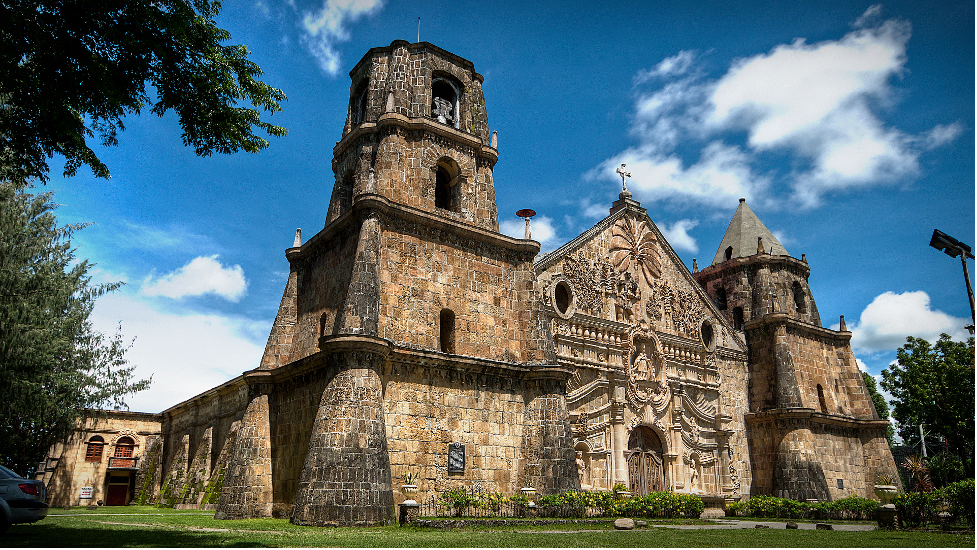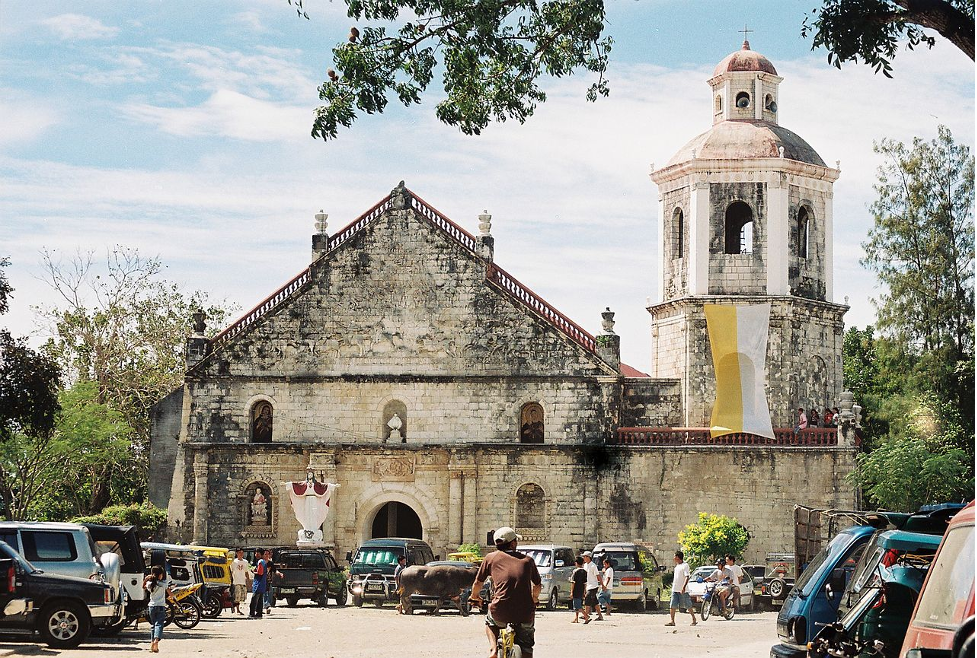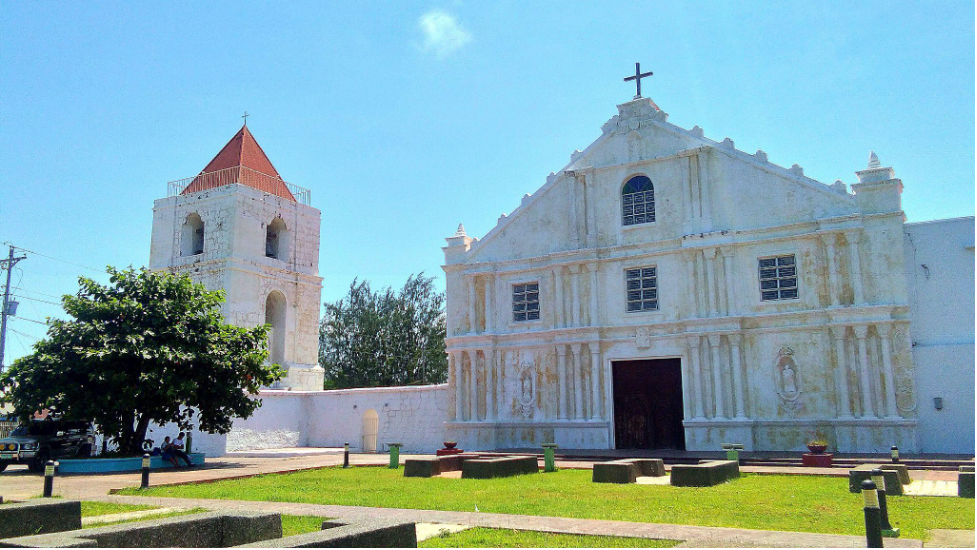The Visayas area was where Roman Catholicism began in the Philippines. And even after centuries of independence from colonial rule, the Catholic faith continues to flourish through the passing down of traditions, teachings, and doctrines from generation to generation. Perhaps one of these customs is to visit different churches and pray, worship, and ask for penance during Holy Week.
As a repository of Roman Catholicism, many provinces in the Visayas house several churches that have withstood war, fires, typhoons, and earthquakes in the past years. If you’re looking for picturesque and tranquil prayer spots, here are seven centuries-old churches you can add to your visita iglesia (Holy Week practice of visiting different churches) journey:
Located in the town of Miag-ao, Iloilo, Miagao Church started as a visita (a church served by a visiting priest) before transitioning into a full parish in 1731. The church has undergone several reconstruction projects as it suffered fire, earthquake, and damage from World War 2. And despite its numerous restorations, Miagao Church remains one of the most beautiful centuries-old basilicas in the Philippines.
While Miag-ao is 40 kilometers away from Iloilo’s capital, traveling to Miagao Church from your apartment for rent in Iloilo City for pilgrimage will be worth it. The church’s patron saint, St. Thomas of Villanova, may grant you guidance, love, and compassion—qualities you might need at work and home.
Another Baroque-style church in the province of Iloilo is San Joaquin Church in the municipality of San Joaquin. It is popular for its pediment, the triangular portion of a wall between intersecting roof pitches, that features the Spanish victory against the Muslims of Maghreb, an event known as the Battle of Tétouan.
As one of the National Cultural Treasures of Iloilo, San Joaquin Church is a must-visit for those practicing visita iglesia. Besides pilgrimage, people who just moved into their house and lot for sale in Iloilo City can go to the San Joaquin Church complex and marvel at the beauty of San Joaquin Cemetery.
Loboc isn’t just known for its beautiful river, floating restaurants, and talented children’s choir. Sitting along the town’s riverbanks is Loboc Church, a Baroque-style basilica that became a parish in 1602. It is classified as a National Historical Landmark and National Cultural Treasure due to its ancient yet well-preserved beauty.
Outside, Loboc Church resembles a castle surrounded by greens and flowing streams. Within the church’s complex are the belltower, mortuary, convent, and sacristy. After attending mass, praying, and asking for penance, take a tour around the Loboc Church complex and marvel at the art and architecture complemented by nature.
Siquijor is known for its spooky tales of witchcraft. But don’t fret about experiencing kulam (black magic) from those whom you have trespassed! You may ask for repentance and spend some tranquil time at Lazi Church, a parish in the town of Lazi dedicated to Saint Isidore the Laborer.
Lazi Church lies in an expansive complex comprising the main parish, convent, and green spaces. A huge portion of the convent is now museum housing artifacts and collections related to catholicism and Siquijor’s history. Inside the neoclassical church are the star dome and altarpiece where you can see images of several saints from whom, perhaps, you can ask for guidance and protection from evil spirits.
Capiz is another province famous for its locals’ accounts of supernatural happenings. But like the previous church, you don’t have to worry about getting eaten by a vampiric creature during your visit to Capiz! Panay Church in Roxas City is there to give you sanctuary and peace.
Panay Church is hailed as a National Historical Landmark in 1997 due to its mostly intact ancient parts. Notable features of the minor basilica include three inscription bells, coral masonry walls, a stairway to the choir loft, and the main altar. A portion of the church serves as a mini-museum where artifacts, Joseph Bergaño’s Bas Relief, and fragments of the original church are housed.
If you’re touring the famous Basilica del Santo Niño in Cebu City, you might also want to explore Boljoon Church in the municipality of Boljoon, Cebu. Starting out as a chapel of ease of Carcar in 1599, Boljoon Church was already dedicated to the Blessed Virgin Mary even before its elevation to a parish in 1690. Marian devotees from Cebu should visit the church to offer their prayers and worship to the Blessed Virgin during and even after Lent.
As a historical landmark, Boljoon Church still has some of its original parts serving their purposes to this day. These items include the retablo (devotional painting), bell tower, and the convent-turned-museum. Within the church complex is the cemetery where you’ll find a symmetrical stone arch gateway, a three-layered pediment, a stone relief with a human skull on top, and a wall with human skulls and bones.
Super typhoon Yolanda may have ravaged Eastern Samar in 2013, but the town of Guiuan proved to be strong and effervescent as ever. Take Guiuan Church as an example. The 300-year old church was heavily damaged by the typhoon, with most of its roof sections destroyed. However, the church’s beauty and glory were restored and rebuilt in 2019.
Due to the typhoon damage, Guiuan Church’s original retablo and other church relics were destroyed. However, you still get a sense of the basilica’s serene and peaceful environment on your visit. Even if the church has new parts, its long history will never fade.
These seven Baroque churches in the Visayas aren’t just stops for praying and worshipping; they are also tangible evidence of the Philippines’ Catholic history and culture. On your visit to these seven beautiful basilicas, take time to reflect while touring the historic church grounds.
Sources:
As a repository of Roman Catholicism, many provinces in the Visayas house several churches that have withstood war, fires, typhoons, and earthquakes in the past years. If you’re looking for picturesque and tranquil prayer spots, here are seven centuries-old churches you can add to your visita iglesia (Holy Week practice of visiting different churches) journey:
Miagao Church (Miagao, Iloilo)
Located in the town of Miag-ao, Iloilo, Miagao Church started as a visita (a church served by a visiting priest) before transitioning into a full parish in 1731. The church has undergone several reconstruction projects as it suffered fire, earthquake, and damage from World War 2. And despite its numerous restorations, Miagao Church remains one of the most beautiful centuries-old basilicas in the Philippines.
 |
Photo by Alienscream on Wikimedia Commons |
While Miag-ao is 40 kilometers away from Iloilo’s capital, traveling to Miagao Church from your apartment for rent in Iloilo City for pilgrimage will be worth it. The church’s patron saint, St. Thomas of Villanova, may grant you guidance, love, and compassion—qualities you might need at work and home.
San Joaquin Church (San Joaquin, Iloilo)
Another Baroque-style church in the province of Iloilo is San Joaquin Church in the municipality of San Joaquin. It is popular for its pediment, the triangular portion of a wall between intersecting roof pitches, that features the Spanish victory against the Muslims of Maghreb, an event known as the Battle of Tétouan.
 |
Photo by Carlponcegarcia on Wikimedia Commons |
As one of the National Cultural Treasures of Iloilo, San Joaquin Church is a must-visit for those practicing visita iglesia. Besides pilgrimage, people who just moved into their house and lot for sale in Iloilo City can go to the San Joaquin Church complex and marvel at the beauty of San Joaquin Cemetery.
Loboc Church (Loboc, Bohol)
Loboc isn’t just known for its beautiful river, floating restaurants, and talented children’s choir. Sitting along the town’s riverbanks is Loboc Church, a Baroque-style basilica that became a parish in 1602. It is classified as a National Historical Landmark and National Cultural Treasure due to its ancient yet well-preserved beauty.
 |
Photo by SieNash on Wikimedia Commons |
Outside, Loboc Church resembles a castle surrounded by greens and flowing streams. Within the church’s complex are the belltower, mortuary, convent, and sacristy. After attending mass, praying, and asking for penance, take a tour around the Loboc Church complex and marvel at the art and architecture complemented by nature.
Lazi Church (Lazi, Siquijor)
Siquijor is known for its spooky tales of witchcraft. But don’t fret about experiencing kulam (black magic) from those whom you have trespassed! You may ask for repentance and spend some tranquil time at Lazi Church, a parish in the town of Lazi dedicated to Saint Isidore the Laborer.
 |
Photo by Allan Jay Quesada on Wikimedia Commons |
Lazi Church lies in an expansive complex comprising the main parish, convent, and green spaces. A huge portion of the convent is now museum housing artifacts and collections related to catholicism and Siquijor’s history. Inside the neoclassical church are the star dome and altarpiece where you can see images of several saints from whom, perhaps, you can ask for guidance and protection from evil spirits.
Panay Church (Panay, Capiz)
Capiz is another province famous for its locals’ accounts of supernatural happenings. But like the previous church, you don’t have to worry about getting eaten by a vampiric creature during your visit to Capiz! Panay Church in Roxas City is there to give you sanctuary and peace.
 |
Photo by Iannekleina on Wikimedia Commons |
Panay Church is hailed as a National Historical Landmark in 1997 due to its mostly intact ancient parts. Notable features of the minor basilica include three inscription bells, coral masonry walls, a stairway to the choir loft, and the main altar. A portion of the church serves as a mini-museum where artifacts, Joseph Bergaño’s Bas Relief, and fragments of the original church are housed.
Boljoon Church (Boljoon, Cebu)
If you’re touring the famous Basilica del Santo Niño in Cebu City, you might also want to explore Boljoon Church in the municipality of Boljoon, Cebu. Starting out as a chapel of ease of Carcar in 1599, Boljoon Church was already dedicated to the Blessed Virgin Mary even before its elevation to a parish in 1690. Marian devotees from Cebu should visit the church to offer their prayers and worship to the Blessed Virgin during and even after Lent.
 |
Photo by Adamdaley on Wikimedia Commons |
As a historical landmark, Boljoon Church still has some of its original parts serving their purposes to this day. These items include the retablo (devotional painting), bell tower, and the convent-turned-museum. Within the church complex is the cemetery where you’ll find a symmetrical stone arch gateway, a three-layered pediment, a stone relief with a human skull on top, and a wall with human skulls and bones.
Guiuan Church (Guiuan, Eastern Samar)
Super typhoon Yolanda may have ravaged Eastern Samar in 2013, but the town of Guiuan proved to be strong and effervescent as ever. Take Guiuan Church as an example. The 300-year old church was heavily damaged by the typhoon, with most of its roof sections destroyed. However, the church’s beauty and glory were restored and rebuilt in 2019.
 |
Photo by Nairb.Idi9 on Wikimedia Commons |
Due to the typhoon damage, Guiuan Church’s original retablo and other church relics were destroyed. However, you still get a sense of the basilica’s serene and peaceful environment on your visit. Even if the church has new parts, its long history will never fade.
These seven Baroque churches in the Visayas aren’t just stops for praying and worshipping; they are also tangible evidence of the Philippines’ Catholic history and culture. On your visit to these seven beautiful basilicas, take time to reflect while touring the historic church grounds.
Sources:
https://en.wikipedia.org/wiki/Baroque_Churches_of_the_Philippines









.jpg)

.jpg)
.jpg)

Post a Comment